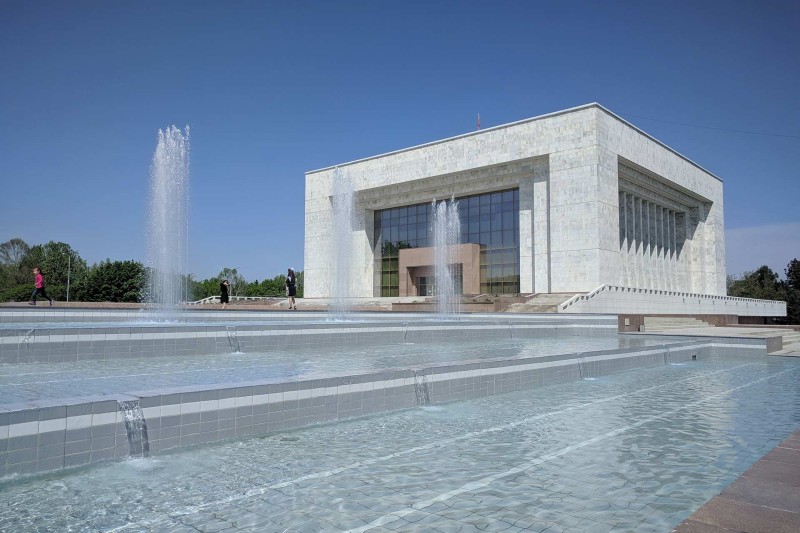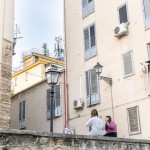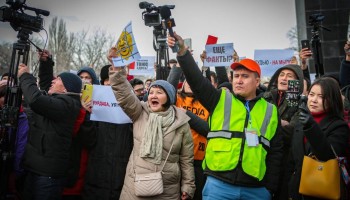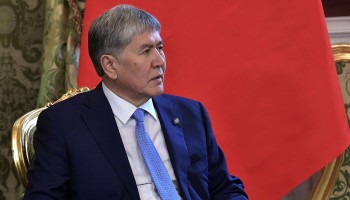When the National History Museum of Kyrgyzstan shut down for renovations in March 2016, the work was supposed to take just 18 months.
But five years later, the US$21.5 million project is still not finished and the museum’s imposing Soviet modernist building in central Bishkek remains closed to the public.
Instead, the work was repeatedly delayed and plagued by a series of controversies: a fire of mysterious origin, the sudden burial of an ancient mummy from the museum’s collection, and a corruption scandal that ultimately sent the country’s former prime minister to prison.
Through it all, the museum administration and the Kyrgyz government have insisted that the museum’s 135,000 exhibits — some dating back to the Stone Age — remain safe.
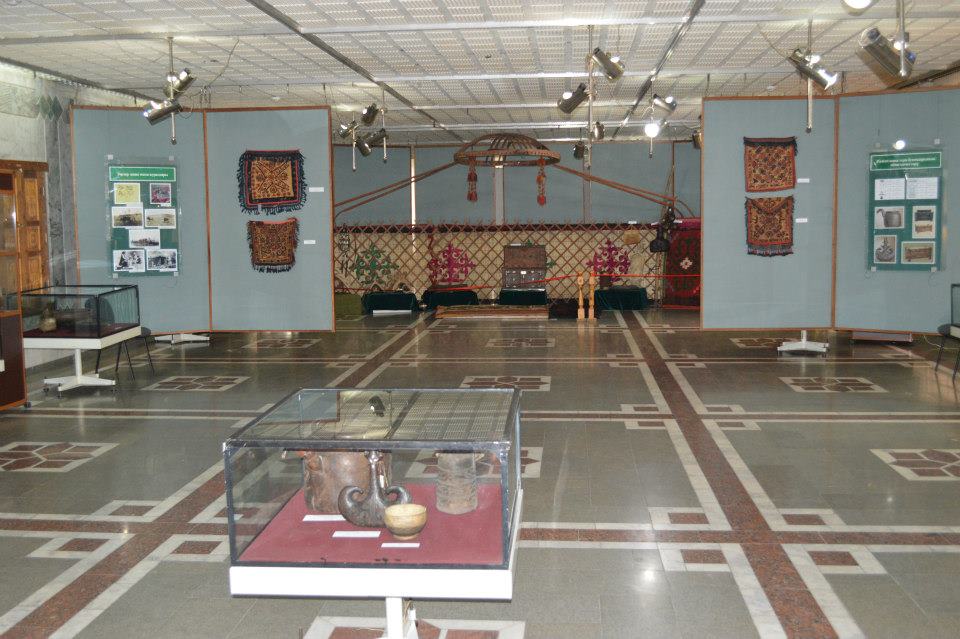 A display in the National History Museum — from before the start of large-scale renovations — features examples of Kyrgyz carpets and traditional household implements. (Credit: National History Museum Facebook Page)
A display in the National History Museum — from before the start of large-scale renovations — features examples of Kyrgyz carpets and traditional household implements. (Credit: National History Museum Facebook Page)
But interviews with curators and documents obtained by OCCRP and its partner in Kyrgyzstan, Kloop, tell a different story.
After a fire broke out at the museum in 2016, many employees who had been placed on unpaid leave became worried that national treasures had been damaged in the blaze, despite government statements to the contrary.
Several employees wrote letters — viewed by reporters — to the Ministry of Culture to express their concerns, but no action appears to have been taken.
“No one even paid attention,” said a furloughed curator who provided reporters with copies of the letters.
Like other current and former museum employees, the curator would only speak on condition of anonymity out of fear that authorities would retaliate against her for speaking to the media.
But evidence obtained by reporters confirms some of the concerns they voiced. Internal museum documents indicate that at least 18 exhibit items were damaged or destroyed in the fire, a finding that directly contradicts the government’s claims. A report by forensic experts, which was never made public, also appeared to suggest that the fire was caused by arson.
Documents and interviews related to the controversial burial of a unique mummy from the museum’s collection in 2017 also contradicted the official narrative about the event.
Museum employees interviewed by reporters said the lack of transparency around both these incidents was concerning and suggested a cover-up of the museum administration’s failure to protect valuable artifacts during the renovation process.
Kadicha Tashbaeva, a Kyrgyz archaeologist who has collaborated closely with the museum, said she was flummoxed by the secrecy around the fire and the mummy’s burial: “They’ve been absolutely silent, as if this never happened,” she said.
Anarkul Isiralieva, the director of the museum between 2010 and 2018, denied mishandling exhibit items and said that decisions about how to store and protect the exhibits were made by the government. The order to bury the mummy also came from the Kyrgyz government, she told reporters.
Fire in the Hall
At 10:12 p.m. on July 22, 2016, Bishkek’s Fire Service received an emergency call: Plumes of smoke were billowing from the museum’s conference hall.
Firefighters rushed to the scene. They found that three of the conference hall’s entrances had been bricked up. The one remaining reinforced metal door was locked and access to the key was extremely limited. After breaking down the brick barricades, dozens of firefighters and five firetrucks spent seven hours extinguishing the flames.
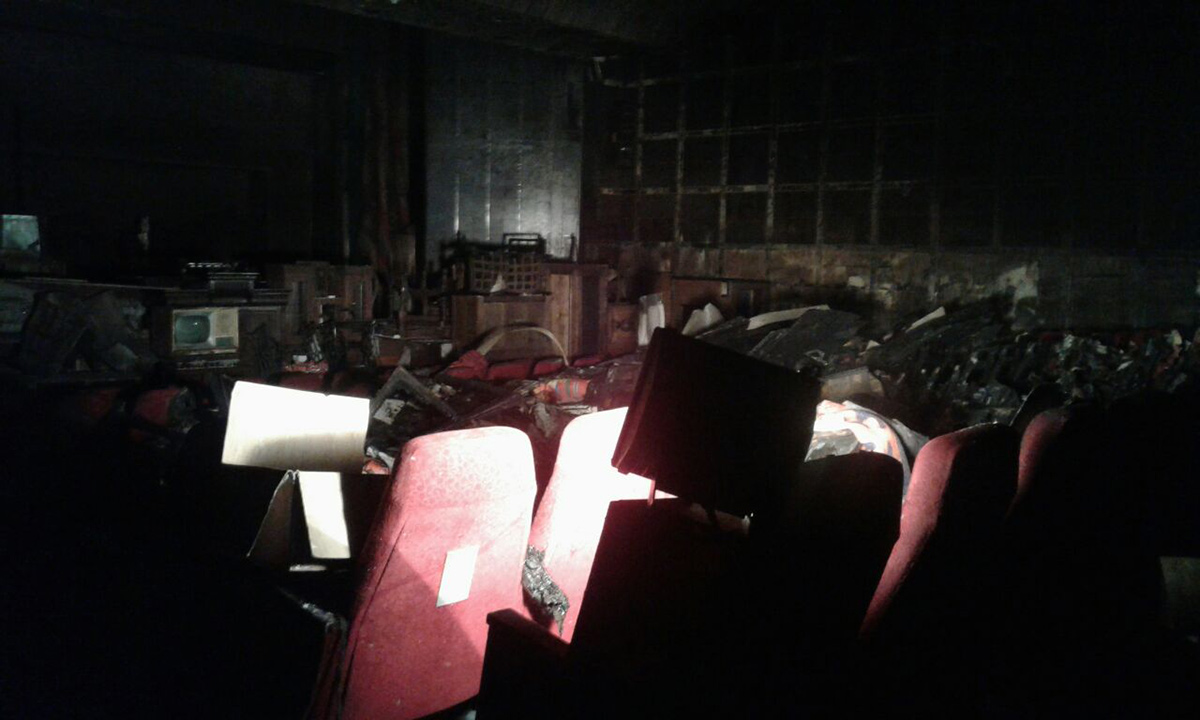 The inside of the museum’s conference hall after the July 2016 fire. (Credit: Provided by a museum employee)
The inside of the museum’s conference hall after the July 2016 fire. (Credit: Provided by a museum employee)
Officials initially said that nothing of value was harmed.
One of these officials, Isiralieva, told a local daily newspaper that only one exhibit item had gone up in flames: an old yurt of so little value that the museum had already been planning to remove it from its collection. All the other exhibits had already been moved to a storage site, she claimed.
But interviews with firefighters and documents obtained by reporters suggest the damage was more widespread than Isiralieva let on. Three firefighters who fought the blaze said the conference hall had been filled with boxes, at least some of which contained exhibit materials.
Moreover, a report from forensic experts who investigated the fire at the request of the Kyrgyz police concluded that the blaze began from “an open fire source with the use of combustion accelerators.” The presence of “multiple independent fire sites” in the hall was consistent with the “combustion of spilled flammable liquids,” the report said.
The experts drew no conclusions about the exact cause of the fire, and their findings were never made public.
The current director of the museum, Keneshbek Almakuchukov, told reporters he did not exclude the possibility of arson, which appeared to be the report’s unstated conclusion. Another employee, who helps manage daily operations at the museum, also raised the same concern in an interview with reporters. She too requested anonymity, fearing retaliation from her employer.
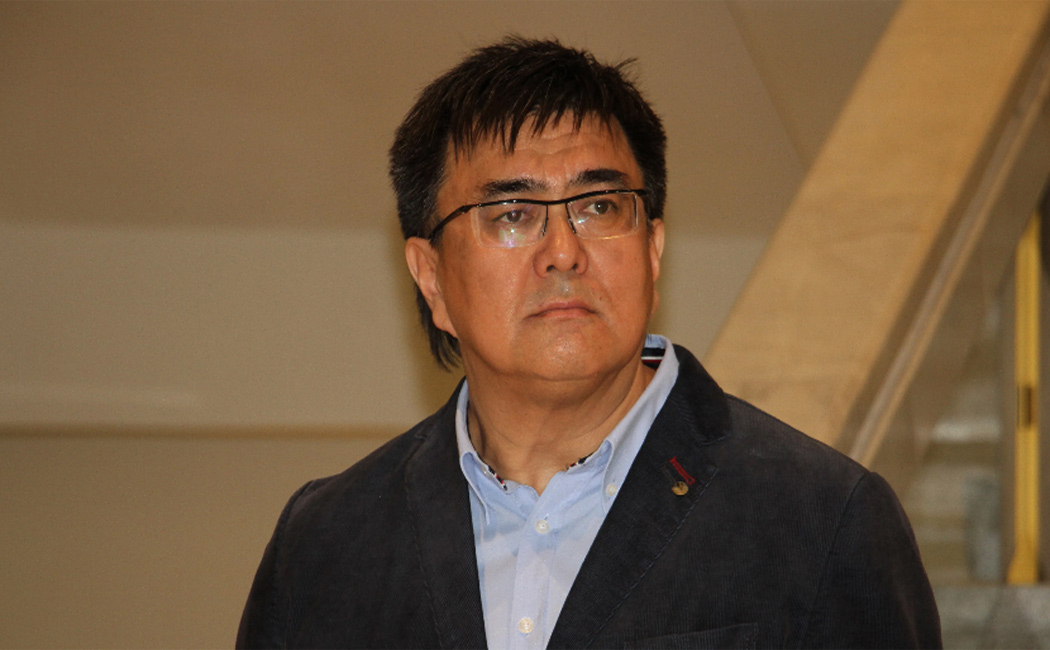 Keneshbek Almakuchukov, the current director of the museum. (Credit: Kloop)
Keneshbek Almakuchukov, the current director of the museum. (Credit: Kloop)
But the museum administration at that time did not accept the idea that the fire had been caused by arson. In a letter to Kyrgyz police written on December 28, 2016, four months after the forensic report was completed, Isiralieva and five other administration officials requested a new investigation, claiming that arson was not possible because the conference hall was guarded by three police posts and was under video surveillance.
Almakuchukov told reporters he doesn’t know what happened with that request. Kyrgyz law enforcement opened a criminal investigation into the fire in 2017, but did not respond to reporters’ questions about the case.
In an interview with Kloop last year, Almakuchukov said the case had still not moved forward.
“Was it arson? Was the fire due to a violation of safety rules? There’s still no answer,” he said.
Nearly five years after the blaze, the extent of the damage also remains unclear.
An internal museum document provided to reporters indicates that at least 18 carpets were damaged in the fire. The document, which includes each item’s official identification number, provides before-and-after images showing extensive damage.
Reporters could not confirm how much the carpets were worth, but two current and two former museum employees, all with direct knowledge of the ethnographic collection and its value, said they had historical significance.
After reviewing the document, the furloughed curator who had provided copies of the letters expressing concerns about the fire said the items were part of the museum’s main collection and were “very valuable.”
A document from the inter-ministerial committee that investigated the fire indicates that it was only after the blaze that authorities decided to remove exhibit items from the conference hall. The museum’s precious metals collection was moved to Kyrgyzstan’s National Bank, while other items were moved to the basement of the Ministry of Culture. It’s impossible to say what else might have been damaged during the fire.
After the blaze was extinguished, the museum’s curators and conservators were not even called in to “help dry” the now wet exhibit items, according to a second curator who spoke with reporters. “Why were the guards and custodial staff working, but not allowing us access?” the curator said.
For archaeologist Tashbaeva, the museum’s handling of the situation was irresponsible.
“These are priceless things. This is the history of culture and ethnography of the Kyrgyz people,” she said. “It burned up in an instant through the carelessness of the museum director, through ignorance of museum affairs.”
Exhibits Lost
In 2013, an inventory of the museum’s collections revealed that more than 500 exhibit items had been lost. According to the Ministry of Culture, the missing items included a 19th-century mace, six silver and bronze coins, porcelain vases, goblets, historical horseback riding gear, clothing, household items, and numerous Soviet medals.
In 2012 and 2017, Kyrgyz law enforcement opened investigations into the missing items. Both were suspended, and the investigators failed to identify suspects, the Kyrgyz Interior Ministry told reporters in an official statement.
Mummy’s Curse
While the origins of the fire remain debated, a second controversy at the museum was clearly manmade.
In October 2017, the Ministry of Culture ordered that a unique, centuries-old mummy be removed from the museum’s collection — and buried.
Archaeologists had discovered the mummified woman in the mid-1950s in Kyrgyzstan’s southwestern Batken region. Initial studies dated it to between the 1st and 5th centuries A.D., making it an important discovery for the country and for archaeologists, who had been planning to further study the mummy.
Kyrgyz psychics and soothsayers, on the other hand, demanded that she be reburied. They blamed the mummy’s presence outside the grave for various cataclysms and turmoil in the country. One even predicted that the 2017 presidential elections would not go ahead peacefully unless it was reburied.
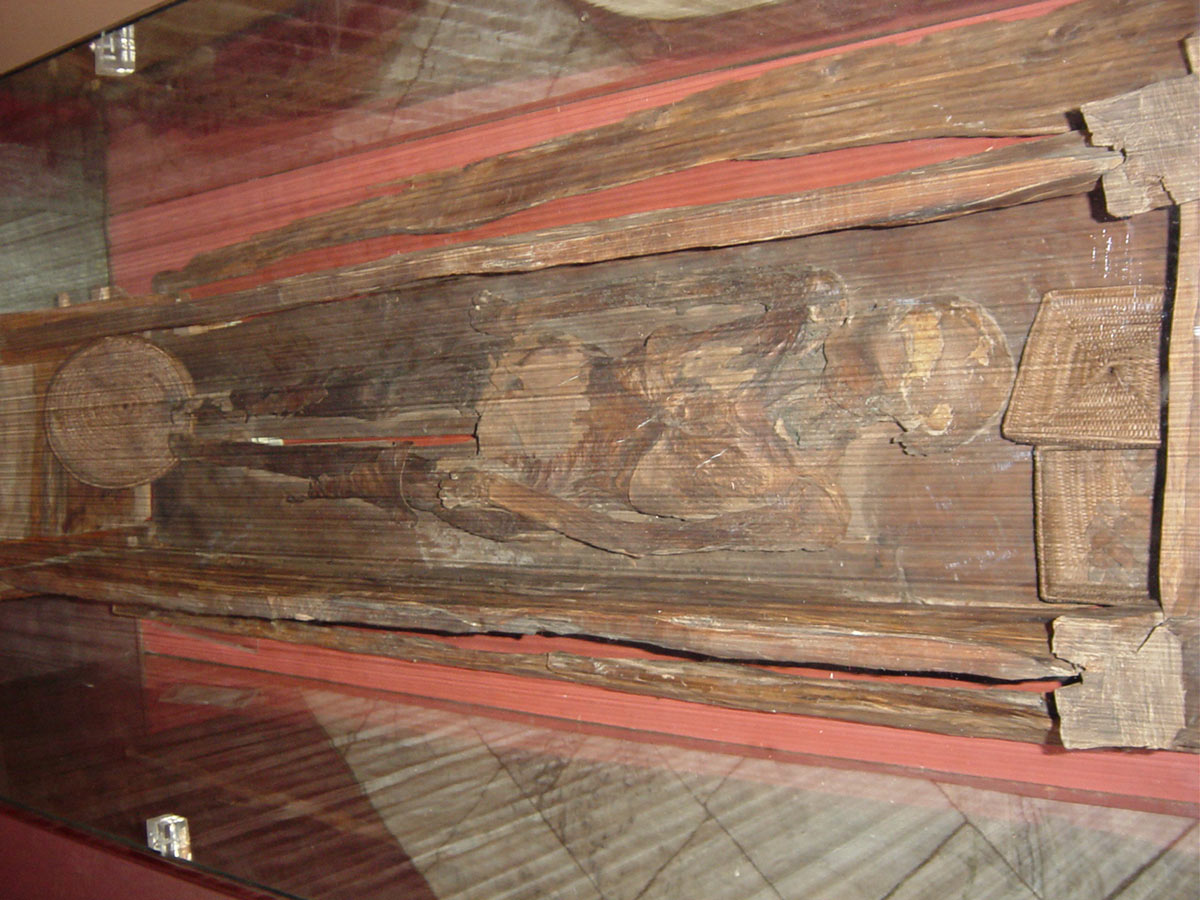 The National History Museum’s mummy. In October 2017, the Kyrgyz government buried the 1,500-year-old relic, despite protest from archaeologists and the scientific community. (Credit: Kubatbek Tabalidev, archeologist, professor at Kyrgyz-Turkish Manas University)
The National History Museum’s mummy. In October 2017, the Kyrgyz government buried the 1,500-year-old relic, despite protest from archaeologists and the scientific community. (Credit: Kubatbek Tabalidev, archeologist, professor at Kyrgyz-Turkish Manas University)
When the authorities decided to inter the mummy just days before the election, it appeared they were giving into the psychics. The Ministry of Culture disputes this, claiming that the mummy was buried because its condition had deteriorated and the museum lacked equipment to preserve it.
But the mummy’s burial galvanized Kyrgyzstan’s scientific community. A letter written by a group of Kyrgyz scientists and archaeologists to the president and prime minister at the time called it an “act of vandalism.”
It also angered many Kyrgyz citizens who felt it represented the malign influence of growing religiosity and increasingly strict interpretations of Islam in their country — an impression furthered by the culture minister at the time, Tugolbai Kazakov, who argued that keeping the mummy wasn’t in line with Kyrgyz traditions. (Kazakov resigned shortly after the mummy scandal, without specifying a reason.)
Documents obtained by reporters and interviews with curators contradict the official narrative, offering a portrait of a hasty, concerted, and possibly illegal effort to eliminate a valuable relic of ancient civilization.
Three Kyrgyz archaeologists with experience studying the mummy — Tashbaeva, Kubatbek Tabaldiev, and Temirlan Chargynov — all told OCCRP that it was in good condition and well maintained, and that it hadn’t yet been fully studied. Even Isiralieva, museum director at the time, acknowledged to reporters that the mummy’s condition was “satisfactory.”
Moreover, rules governing the disposal of museum items state that neither the museum nor the government can simply remove items from the collection. When an exhibit item is damaged, the museum is supposed to convene an internal commission, document the damage, receive an assessment from relevant government authorities, and have its value appraised by experts. Only then can the Culture Minister decide to remove it from the collection.
But a curator who would have been included said that no such commission was ever held for the mummy. Reporters also could not find any documentary evidence of such a commission, and the museum administration did not respond to questions about whether such deliberations were ever held.
Instead, the Ministry of Culture held a different type of inter-ministerial commission that was not appropriate for the occasion. It met just twice, included few experts on archaeology, and concluded with unusual haste, considering that the item was part of the museum’s main collection.
The official minutes of the commission’s second session on October 12, 2017 show only brief deliberations before the group voted on the mummy’s fate.
Just under a week earlier, on October 6, Baktybek Sekimov, state secretary of the Ministry of Culture, had sent a letter asking the government to remove the mummy from the museum collection and bury it. A day before the meeting, the government had already ordered several ministries to take part in the burial.
Tashbaeva, the archaeologist, was one of the few commission members to oppose the burial. She told reporters that she was invited to participate just 24 hours before the meeting.
For the museum’s employees, the mummy’s burial was a shock. It is still unclear why the authorities decided to eliminate the artifact.
“In 15 years, I don’t remember one case when we eliminated [an item] from the main collection,” the furloughed curator said. “Not one was eliminated. They didn’t allow us to do that.”
No End in Sight
Today, renovation work is almost finished, but the museum’s reopening still appears to be a long way off.
The Ministry of Culture told reporters that several issues are delaying the reopening. The Kyrgyz government still owes a German contractor nearly 226,000 euros. The Interior Ministry has not yet conducted a trial run of the museum’s new security system. And the museum is also experiencing IT problems.
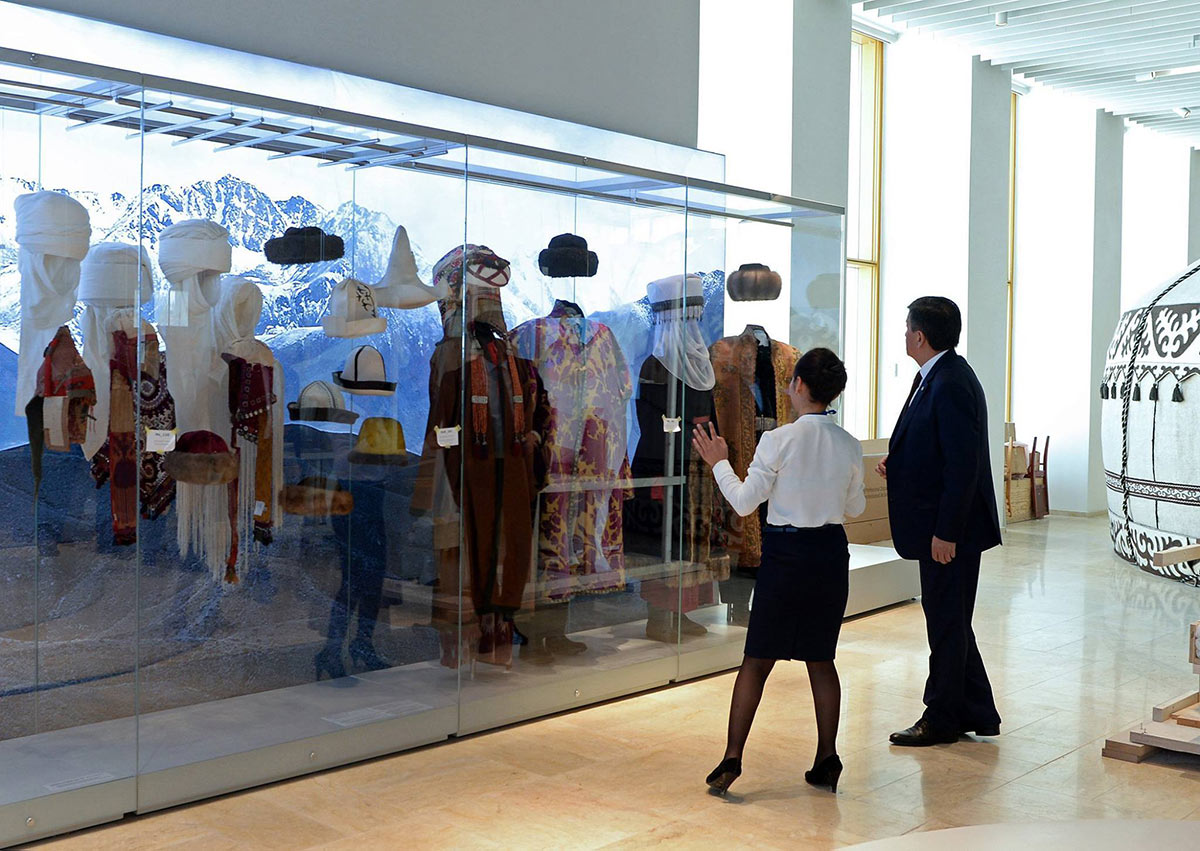 A tour guide shows then Kyrgyz President Sooronbay Jeenbekov an exhibition of traditional Kyrgyz clothing at the museum on Jan 12, 2018. At that time the museum was already closed to the public and undergoing large-scale renovations. (Credit: Official website of the president of Kyrgyzstan)
A tour guide shows then Kyrgyz President Sooronbay Jeenbekov an exhibition of traditional Kyrgyz clothing at the museum on Jan 12, 2018. At that time the museum was already closed to the public and undergoing large-scale renovations. (Credit: Official website of the president of Kyrgyzstan)
An ongoing court case over how the renovation money was spent may also become a hurdle to reopening, the ministry said.
In June 2018, lawmakers from Ata-Meken, an opposition political party, accused the government of purchasing furniture for the museum at inflated prices. At a press conference held at the museum, lawmaker Kanybek Imanaliev pointed to an unimpressive pink chair and claimed that it had been purchased for 100,000 Kyrgyz som — roughly $1,180.
“This is budget money, our money. Couldn't these funds have been used to repair hospitals?” Imanaliev said.
Reporters were not able to verify Imanaliev’s claim, and requests for evidence sent to lawmakers went unanswered.
Shortly after, Kyrgyz prosecutors opened a criminal investigation into the case. They eventually concluded that former Prime Minister Sapar Isakov, who was overseeing the project, as well as a former presidential administration official, had caused at least $1.2 million in losses to the state budget in the course of the museum renovations.
During one court hearing, Isakov called his trial “politically motivated” and alleged that President Sooronbai Jeenbekov was personally behind it. The former prime minister was one of several politicians who faced criminal charges during a conflict between Jeenbekov and his predecessor, Almazbek Atambayev. The charges against Atambayev-affiliated politicians like Isakov were perceived to be part of the political battle.
In June 2020, a Bishkek district court sentenced Isakov to 18 years in prison for abusing state funds during the museum’s renovation and on several other corruption charges. Four months later, he escaped from prison after a popular uprising toppled the government of President Sooronbai Jeenbekov.
Two months after the uprising, the Supreme Court overturned the ruling in Isakov’s case. He and his alleged co-conspirators will now be retried. Isakov, who is believed to have fled the country, could not be reached for comment. However he reportedly denied his guilt in court.
Meanwhile, the museum remains closed, five years and $21.5 million after the renovations first began. Furloughed employees have been allowed to return to the building, but they say they still have no access to exhibit items, which remain locked away.
“Now so many years have passed and (the museum) still isn’t open,” the museum employee who helps manage daily operations said. “It’s hard to imagine what has happened to them.”
With additional reporting by Aidai Tokoeva.
